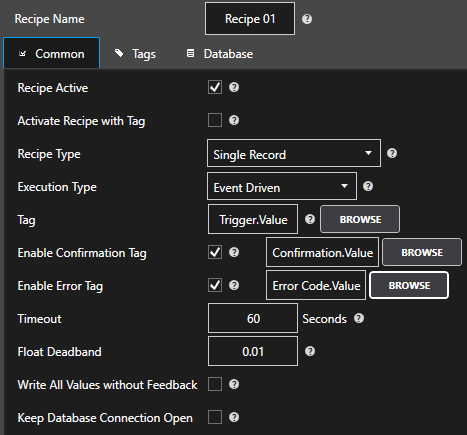Recipe Common Properties

Recipe Name
The name that identifies the Recipe in the Recipes configuration. This name appears in System Alarms if there is a failure with the Recipe.
Recipe Active
Enables or Disables the Recipe. This can be controlled with a Tag Parameter value if Activate Recipe With Tag (see below) is specified. This does not initiate the execution, simply enables or disables the ability to execute the Recipe.
Activate Recipe With Tag
When enabled the Recipe Active selection is controlled with the specified Tag and Parameter that is specified. When the value of the Tag Parameter is True the Recipe is set to Active, and when the value is False the Recipe is set to Inactive.
Recipe Type
Recipe Types:
- Wide Table: Database fields are mapped to Tags to update in the Tags tab of the recipe group. When the recipe executes the TOP record values are transferred to the defined tags.
- Narrow Table: The Tag names and values are all defined directly in the database table. The field names for the Tag names and values are set in the Tags tab. When the recipe executes the multiple records returned will contain the tag names and the values to write.
- Queued Wide Table: Database fields are mapped to Tags to update in the Tags tab of the recipe group. When the recipe executes the TOP record values are transferred to the defined tags. When the recipe execution completes successfully the records are deleted.
- Queued Narrow Table: The Tag names and values are all defined directly in the database table. The field names for the Tag names and values are set in the Tags tab. When the recipe executes the multiple records returned will contain the tag names and the values to write. When the recipe execution completes successfully the records are deleted.
- OEM: Custom recipe routines are executed that are defined by the OEM Code. Not applicable unless your company is working with Open Automation Software directly for the custom recipe type.
Execution Type
Execution types:
- Continuous: Transfer data at the specified Execution Rate. The minimum execution rate is 1 second.
- Event Driven: Transfer data when the Event Driven Execution Tag Parameter value transitions from False to True. The time resolution for this feature is 1 second as the Tag Parameter can be specified from a remote OAS Service.
- Specific Time Of Day: Transfer occurs at the specific Time Of Day.
Execution Rate
The rate of desired data transfer when the Execution Type is set to Continuous. The minimum execution rate is 1 second and the actual data transfer will depend also on the time that the database table can be queried to return the data. Recipe Active must also be set to True.
Tag to Execute Recipe
With the Execution Type is set to Event Driven this is the Tag Parameter that will cause the transfer to occur when the value transitions from False to True. The time resolution for this feature is 1 second as the Tag Parameter can be specified from a remote OAS Service. Recipe Active must also be set to True.
Time Of Day
With the Execution Type set to Specific Time Of Day this will be the time that the transfer will occur. Recipe Active must also be set to True.
Enable Confirmation Tag
When enabled a Boolean Tag can be specified to receive confirmation of a successful Recipe execution. The specified Tag value will be set to false when Recipe first executes and will be set to True after all of the values to transfer have been successfully confirmed to be transferred.
Enable Error Tag
When enabled a Boolean Tag can be specified to receive an integer value with error codes to show what failure if any occurred. The specified Tag value will be set to 0 when Recipe first executes and will be set to a positive number if an error occurs.
0 = No error has occurred.
1 = No records to transfer.
2 = Database error in connection or table read.
3 = Timeout of values, one or more of the Tags did not report the same value back that was written within the Timeout (see below) period.
4 = Unable to delete Queued Record after the transfer was completed.
5 = OAS Recipe is not licensed.
6 = One or more of Tags has Bad Quality
7 = One or more of the Database Read Fields was Bad Quality
8 = One or more of the Tags was not setup to write.
Timeout
This is the amount of time the system will wait for a successful completion of data transfer before giving up and alarming the execution as a failure. If a failure of database connection occurs the failure will be reported immediately.
Float Deadband
When comparing database values written to Tags against the actual feedback values this is the allowable deadband for all values of Float type. This feature is useful for OPC values from PLCs for different resolutions than a 64 bit Double Float.
As long as the values are within the deadband no timeout will occur and the confirmation bit will be set.
To disable this feature for exact comparison on all float values set the value to 0.
